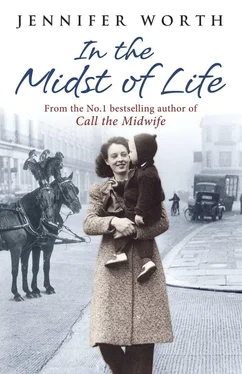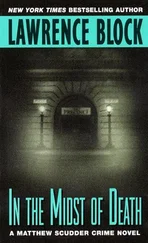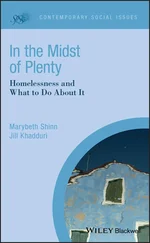Jennifer Worth - In the Midst of Life
Здесь есть возможность читать онлайн «Jennifer Worth - In the Midst of Life» весь текст электронной книги совершенно бесплатно (целиком полную версию без сокращений). В некоторых случаях можно слушать аудио, скачать через торрент в формате fb2 и присутствует краткое содержание. Жанр: Биографии и Мемуары, на английском языке. Описание произведения, (предисловие) а так же отзывы посетителей доступны на портале библиотеки ЛибКат.
- Название:In the Midst of Life
- Автор:
- Жанр:
- Год:неизвестен
- ISBN:нет данных
- Рейтинг книги:3 / 5. Голосов: 1
-
Избранное:Добавить в избранное
- Отзывы:
-
Ваша оценка:
- 60
- 1
- 2
- 3
- 4
- 5
In the Midst of Life: краткое содержание, описание и аннотация
Предлагаем к чтению аннотацию, описание, краткое содержание или предисловие (зависит от того, что написал сам автор книги «In the Midst of Life»). Если вы не нашли необходимую информацию о книге — напишите в комментариях, мы постараемся отыскать её.
In the Midst of Life — читать онлайн бесплатно полную книгу (весь текст) целиком
Ниже представлен текст книги, разбитый по страницам. Система сохранения места последней прочитанной страницы, позволяет с удобством читать онлайн бесплатно книгу «In the Midst of Life», без необходимости каждый раз заново искать на чём Вы остановились. Поставьте закладку, и сможете в любой момент перейти на страницу, на которой закончили чтение.
Интервал:
Закладка:
A hospice for the dying was unknown and unacceptable to the decision-makers of the National Health Service in the 1960s and they would not support it, so private money had to be found. Fundraising was a massive task. Millions had to be raised, a building site found and purchased, architects instructed and planning permission obtained. Dr Saunders had many helpers and admirers, people who were also aware of the neglect of the dying, and who were inspired by her visionary outlook and inexhaustible energy. Money was raised, obstacles overcome, and in 1967, nearly thirty years after the young nurse first heard her calling, St Christopher’s Hospice was opened in Sydenham, Kent.
Planning, building, fundraising – that was the easy part. Even research into the control of pain was easy, compared with the next part – the need to change medical and social attitudes to death.
The primary objective of the hospice movement was, and still is, to show to the world that death need not be a time of suffering, but a time in which to achieve fulfilment. This does not mean a grand ending to a brilliant life; it encompasses the quiet, unsung lives of millions of ordinary people who have lived simply, within a small circle, doing their best and achieving great things in small ways. My mother-in-law was such a person. She had done nothing spectacular in her life, but she was a good woman and, in human understanding, she was one of the wisest people I have known.
She died in her daughter’s arms, quietly and peacefully, as she had lived. This is what I mean by the fulfilment of life.
The hospice movement strives to achieve this, working towards the mental, physical, spiritual and emotional well-being of each patient as he or she approaches the end.
Meticulous, skilled nursing is the most important part of the care of the dying, and the nurse becomes a central figure in the patient’s life. Dr Saunders knew this – had she not been a nurse herself? Most nurses are by nature kind and compassionate, but they need special training, and Cicely Saunders’ series of six articles on the Care of the Dying in the Nursing Times (1959–61) were seminal in the development of the profession and it has been found that those who specialise in palliative care usually find it so rewarding that they do not want to return to mainstream medicine.
Death is a family affair – or should be –just as a new birth involves the whole family. But dying at home often needs professional help, and this was another part of Dr Saunders’ vision – to maximise home visiting. St Christopher’s Hospice trained nurses to work in the community and, today, practically every hospice in the country has its own specialised nurses working in people’s homes so that a dying patient does not have to go into a hospital or even a hospice. In addition, we have, in the UK, over three thousand Macmillan Nurses who have had five years of training and who work exclusively with cancer patients and those who wish to die at home. This work is mostly funded by charity donations. The National Health Service provides about twenty per cent of the total cost.
Dr Saunders’ achievement was truly staggering. ‘The Care of the Dying’ is a fairly common phrase now, and most people do not realise that it is a relatively recent branch of medicine, with its own specialist training, research and disciplines. Today. around two hundred and fifty Hospices for the Care of the Dying exist all over the country, and this does not include specialist palliative care units in most general hospitals. It has become an international movement – over one hundred countries now have their own hospice care, and look to the teaching of Cicely Saunders as to how they should be run.
Dame Cicely Saunders died of cancer in 2005 at the age of eighty-seven, in St Christopher’s Hospice.
It is interesting to compare the lives of Cicely Saunders and Elisabeth Kubler-Ross. They were about the same age - Cicely the elder by eight years - and they died within a year of each other. They both had war experience, when death was all around. With no known contact between each other, they both saw the needs and suffering of dying patients in English and American hospitals in the post-war era. They both identified the cause as the widespread denial of death by the medical professions and society at large. The work undertaken by both of them was groundbreaking. It is one of those fascinating instances where two people with brilliant, insightful minds identify the same problem at the same time and work towards different but complementary solutions. Cicely started the hospice movement in 1967 when St Christopher’s Hospice was opened. Elisabeth published On Death and Dying in 1969. The contribution they made to medicine and to society was immeasurable.
1957
DR CONRAD HYEM
In 1957 I worked in Poplar, East London, with an order of nursing nuns and was required to visit a Mr Hyem, who lived in one of the tenements known as Canada Buildings. They were densely populated and regarded as slums.
I climbed the stone stairs, went along the balcony to his flat, and was taken aback by a small brass plate on the door stating: ‘Dr Conrad Hyem, Doctor of Philosophy and Psychology’. The day book had called him ‘Mr Hyem’, so I assumed the ‘Doctor’ was the wit of some Cockney joker, to amuse himself and his mates. I raised my hand towards the knocker, but at that second the beautiful soaring tones of a violin sounded from within. I stood outside the door, holding my breath, staring unbelievingly at the door. A woman called out:
‘Go on. It’s only the Doc. ’E’s lovely, ’e is. ’E gives us all a toon. Jus’ knock. ’E’ll soon stop.’
I shook my head and put my fingers to my lips, breathing ‘ssshhh’, and leaned closer to the door. The music was beautiful, full-bodied and rich, filled with that plaintive yearning which of all instruments the violin can achieve to perfection.
‘Makes yer wanna cry, ’e do, sometimes,’ the woman sniffed appreciatively. ‘But jest give ’im a knock, ’e won’t mind, ’e’ll soon stop, ’e will.’
Again I shook my head. How could I disturb such a musician, his inner thoughts and emotions? He might never recapture that moment. The final cadence approached, and the last note died away, and I rapped on the knocker.
A tall, silver-haired gentleman opened the door. He was well-built and solid, but not fat. He smiled at me, and the gold fillings in his teeth gleamed in the sunlight. He was wearing well-cut trousers, a plain, high-necked jumper and thick horn-rimmed glasses, and when he smiled, his eyes crinkled attractively at the corners. His hands were beautiful; white and smooth, with polished nails – certainly not the hands of a dock labourer. Nor was he the Cockney humorist I had imagined. I knew at once that he really must be a doctor – of some sort.
‘You must be the nurse I was told to expect.’
He spoke beautiful English with a soft guttural accent, which I took to be German.
‘A small matter concerning my diabetes?’
He opened the door wider and with a slight bow said, ‘Be pleased to enter.’
If I had been surprised to find a musician and scholarly gentleman in the seedy purlieus of the Canada Buildings, it was as nothing compared with my astonishment on entering his rooms. It might have been the study of an Oxford don. Every wall was lined with books from floor to ceiling, thousands of them, mostly leather-bound, some of them with gold tooling down the spine. In front of the window stood a kneehole desk, probably antique, with a beautiful surface of red leather, tooled in gold. A red, leather writing chair stood before the desk and the room held no other furniture save a rosewood music stand. All the shelves were made of warm mahogany, and the lovely smell of wood and leather filled the room. Dr Hyem noticed my reaction, and his eyes crinkled at the corners.
Читать дальшеИнтервал:
Закладка:
Похожие книги на «In the Midst of Life»
Представляем Вашему вниманию похожие книги на «In the Midst of Life» списком для выбора. Мы отобрали схожую по названию и смыслу литературу в надежде предоставить читателям больше вариантов отыскать новые, интересные, ещё непрочитанные произведения.
Обсуждение, отзывы о книге «In the Midst of Life» и просто собственные мнения читателей. Оставьте ваши комментарии, напишите, что Вы думаете о произведении, его смысле или главных героях. Укажите что конкретно понравилось, а что нет, и почему Вы так считаете.












